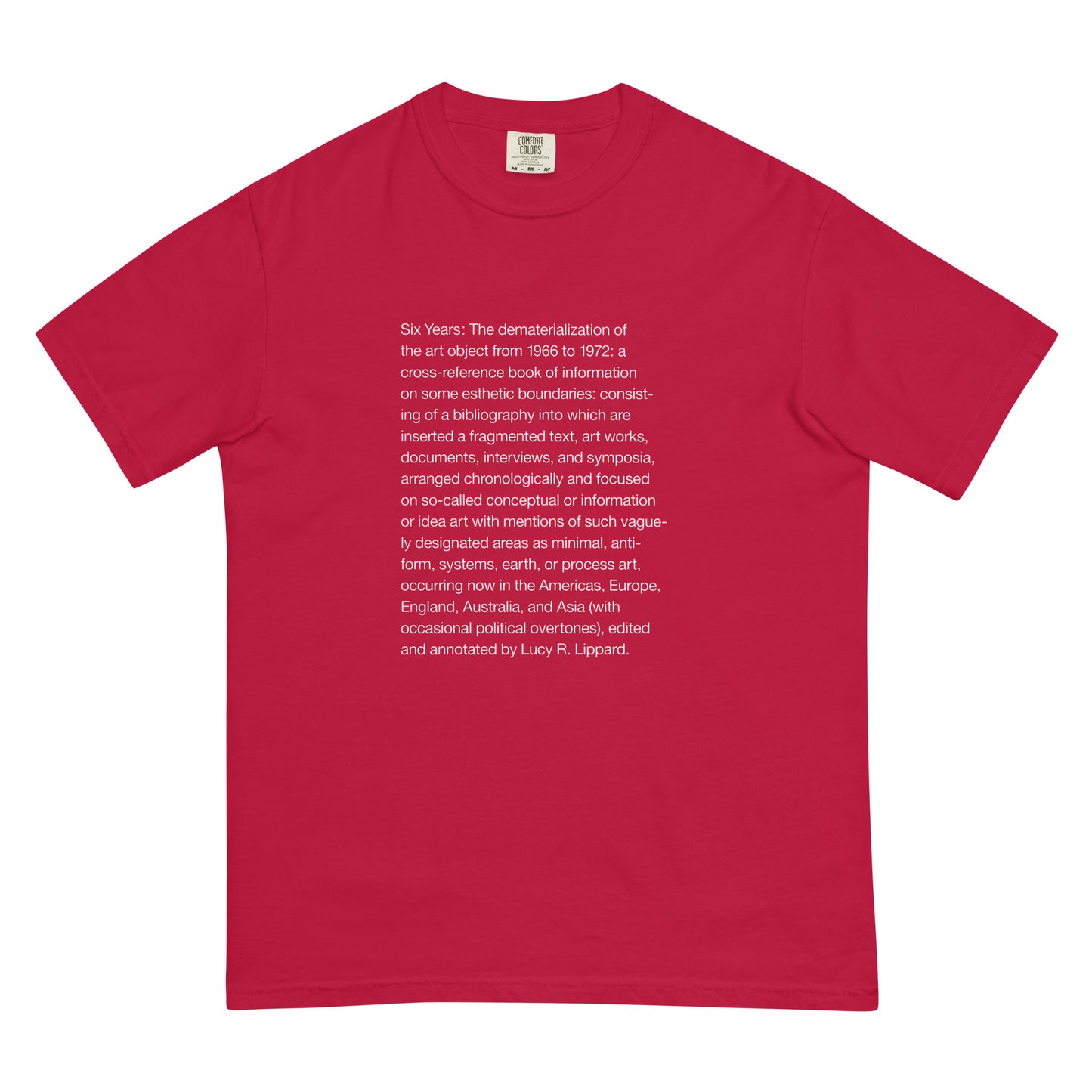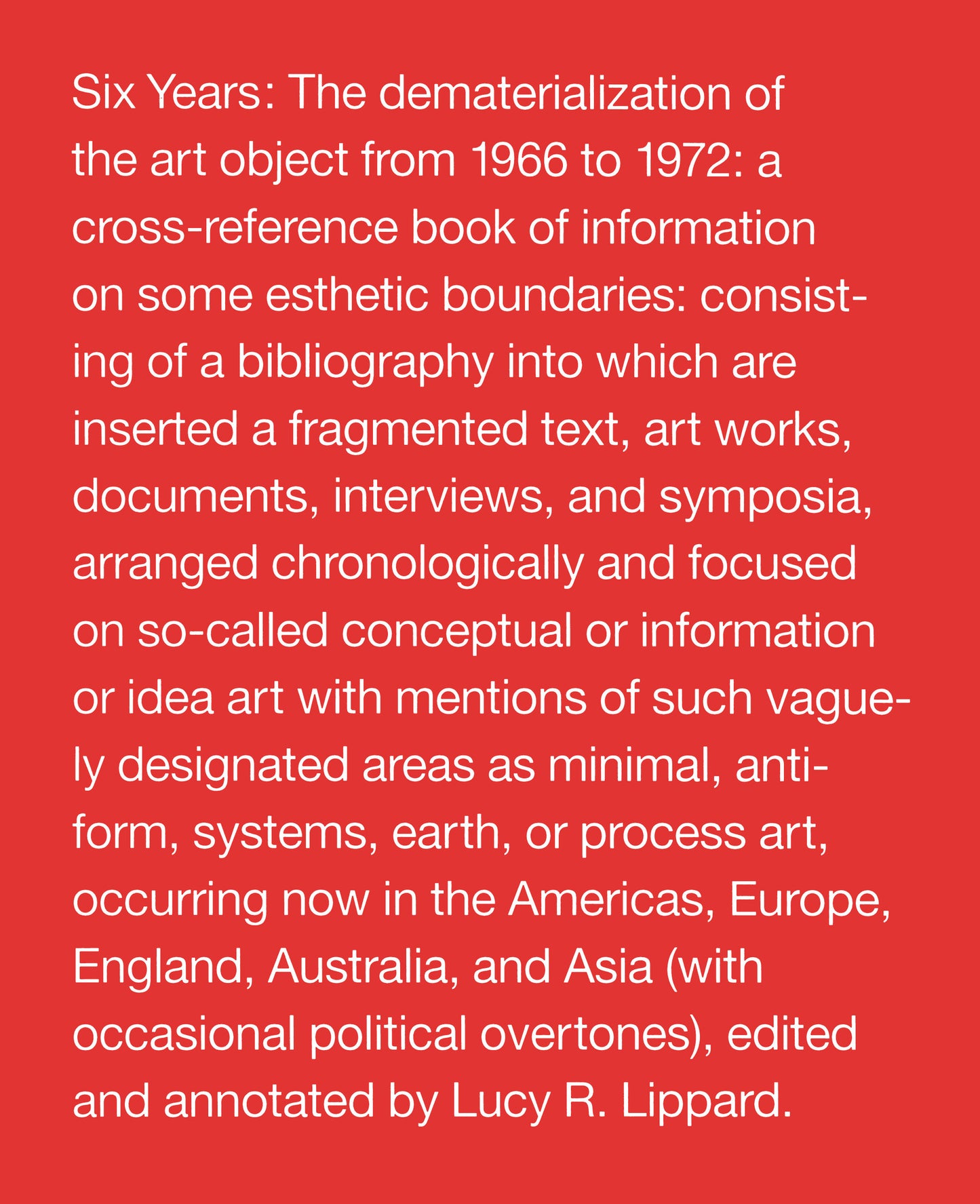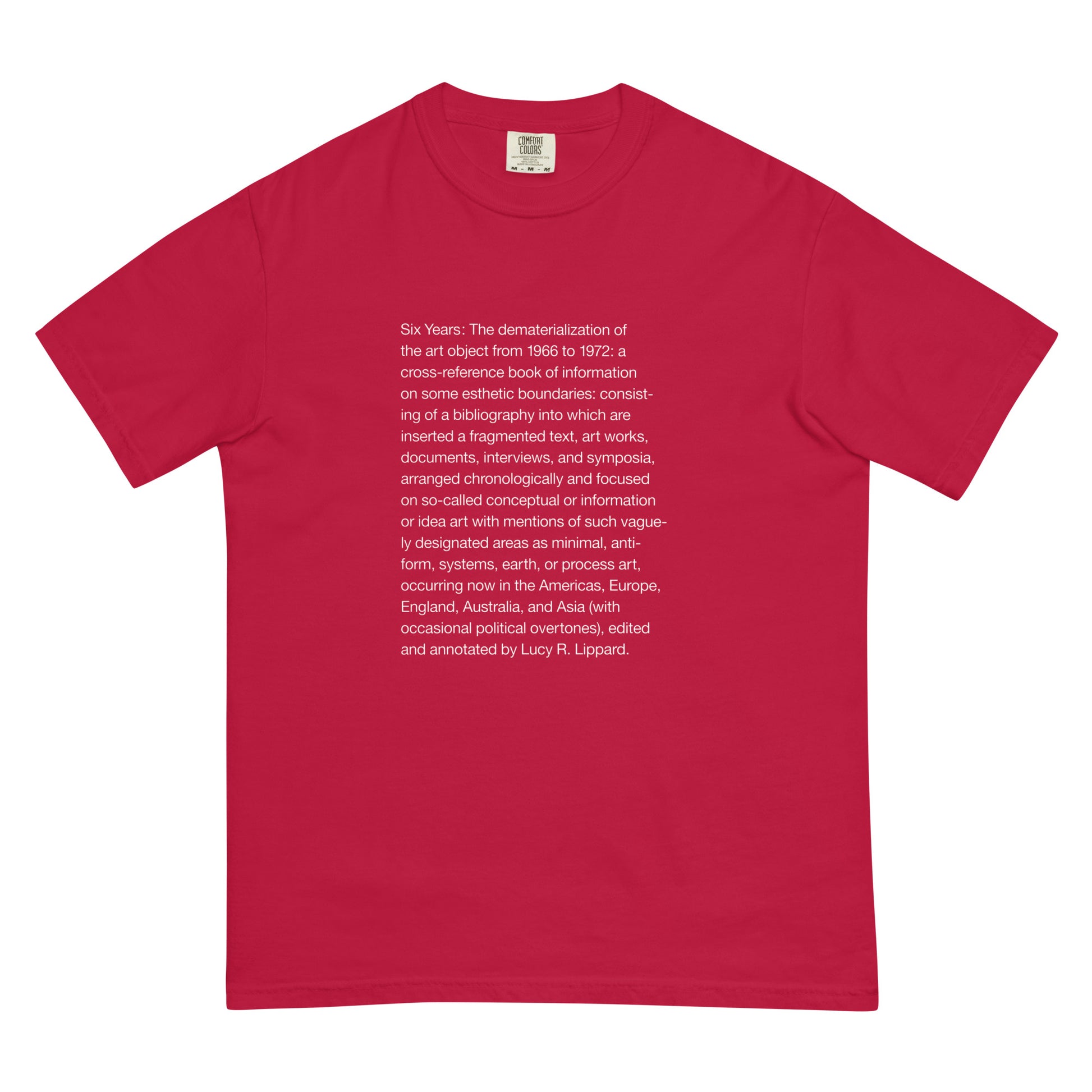Minor Canon
Lucy Lippard Six Years t-shirt
Regular price
£14.00 GBP
Regular price
Sale price
£14.00 GBP
Unit price
per
Shipping calculated at checkout.
Couldn't load pickup availability
In 1973 the critic and curator Lucy R. Lippard published Six Years, a book with possibly the longest subtitle in the bibliography of art: The dematerialization of the art object from 1966 to 1972: a cross-reference book of information on some esthetic boundaries: consisting of a bibliography into which are inserted a fragmented text, art works, documents, interviews, and symposia, arranged chronologically and focused on so-called conceptual or information or idea art with mentions of such vaguely designated areas as minimal, anti-form, systems, earth, or process art, occurring now in the Americas, Europe, England, Australia, and Asia (with occasional political overtones) edited and annotated by Lucy R. Lippard. Six Years, sometimes referred to as a conceptual art object itself, not only described and embodied the new type of art-making that Lippard was intent on identifying and cataloging, it also exemplified a new way of criticizing and curating art.
Since its first publication in 1973, and especially after its reprinting in 1997, Lippard's book has become the definitive and indispensable history of conceptual art's genesis, first flourishing, and (arguably) its disintegration and dispersion in the early 1970s. In its formal mimicry of the art that it documents — a mixture of detached, exhaustive information about exhibitions, publications, and events with frequently personal (if understated) editorializing and commentary — it refects Lippard's blurred identity as curator, writer, critic, and quasi-artist (though she disavowed the last role). In filtering a tremendous volume of factual material through her own experience, sensibility, and history, she follows the conceptual tendency to blur rationalist, bureaucratic procedures with arbitrariness and eccentricity, while also demonstrating her allegiance to conceptual art's attack on the institutions of critical connoisseurship and gatekeeping. As artists assumed the role of critic, philosopher, or simply presenter of information-as-art, they bypassed traditional criticism's methods and standards of evaluation. As Lippard wrote in the 1968 essay on dematerialization that she co-authored with John Chandler, “Judgment of ideas is less interesting than following the idea through.” Accordingly, Six Years is exactly that kind of “following-through”: Lippard presents textual fragments and photographic documents that are presumed to speak (mostly) for themselves. This linguistic model, in which art and its form of presentation are collapsed into the same “primary source” and in which juxtaposed elements (textual or not) function like parts of a sentence (as a proposition or argument) constitutes one of the major shifts in 20th-century art that Six Years both records and enacts. A statement made by Ian Burn and Mel Ramsden in 1970 and included in the book is illustrative: “the area of attention is shifting from single iconic elements (art-objects, art works) to comprise a whole continuum of these elements in a sign-process (semiosis).” (136)
This linguistic turn is closely linked, if not exactly identical, to the process of “dematerialization” that Lippard presents as the crux of conceptual art. In her introductory essay “Escape Attempts,” penned for the 1997 reprint, she writes that, for her, conceptual art is “work in which the idea is paramount, and the material form is secondary, lightweight, ephemeral, cheap, unpretentious and/or 'dematerialized'” (vii). At various points in the book, Lippard includes voices dissenting against the notion of dematerialization and asserting the continued existence and/or significance of art's material elements. Carl Andre pops up on several occasions to insist that art is essentially concerned with the transformation of materials, or to polemicize against “concepts” in general. Memorably: “I have very few ideas but I have some strong desires. I want what is not yet in the world. Ideas are a dime a dozen” (157).
What's clear is that, for Lippard, at least at the time, the idea of dematerialization was intimately connected with her own burgeoning radicalization (often associated with her 1968 travels in Latin America) and that of American culture in general at the time (feminism, civil rights struggle, anti-Vietnam protest). As Lippard herself notes, the “occasional political overtones” alluded to in the full version of Six Years' title were really more like undertones, but they comprise the real “narrative” of the book when it is read through in full. In particular, one can trace Lippard's journey through conceptual art as a process of radicalization and disillusionment that culminates, after the period covered by the book, in her full commitment to and focus on feminism and ecological issues. In the short “Postface” of the original edition, she already noted that, “Hopes that 'conceptual art' would be able to avoid the general commercialization, the destructively 'progressive' approach of modernism, were for the most part unfounded” (263).
• 50% cotton, 50% polyester
• Pre-shrunk
• Classic fit
• 1x1 athletic rib knit collar with spandex
• Air-jet spun yarn with a soft feel and reduced pilling
• Double-needle stitched collar, shoulders, armholes, cuffs, and hem
• 100% ring-spun cotton
• Fabric weight: 6.1 oz/yd² (206.8 g/m²)
• Garment-dyed
• Relaxed fit
• 7/8″ double-needle topstitched collar
• Twill-taped neck and shoulders for extra durability
• Double-needle armhole, sleeve, and bottom hems
• Blank product sourced from Honduras
Since its first publication in 1973, and especially after its reprinting in 1997, Lippard's book has become the definitive and indispensable history of conceptual art's genesis, first flourishing, and (arguably) its disintegration and dispersion in the early 1970s. In its formal mimicry of the art that it documents — a mixture of detached, exhaustive information about exhibitions, publications, and events with frequently personal (if understated) editorializing and commentary — it refects Lippard's blurred identity as curator, writer, critic, and quasi-artist (though she disavowed the last role). In filtering a tremendous volume of factual material through her own experience, sensibility, and history, she follows the conceptual tendency to blur rationalist, bureaucratic procedures with arbitrariness and eccentricity, while also demonstrating her allegiance to conceptual art's attack on the institutions of critical connoisseurship and gatekeeping. As artists assumed the role of critic, philosopher, or simply presenter of information-as-art, they bypassed traditional criticism's methods and standards of evaluation. As Lippard wrote in the 1968 essay on dematerialization that she co-authored with John Chandler, “Judgment of ideas is less interesting than following the idea through.” Accordingly, Six Years is exactly that kind of “following-through”: Lippard presents textual fragments and photographic documents that are presumed to speak (mostly) for themselves. This linguistic model, in which art and its form of presentation are collapsed into the same “primary source” and in which juxtaposed elements (textual or not) function like parts of a sentence (as a proposition or argument) constitutes one of the major shifts in 20th-century art that Six Years both records and enacts. A statement made by Ian Burn and Mel Ramsden in 1970 and included in the book is illustrative: “the area of attention is shifting from single iconic elements (art-objects, art works) to comprise a whole continuum of these elements in a sign-process (semiosis).” (136)
This linguistic turn is closely linked, if not exactly identical, to the process of “dematerialization” that Lippard presents as the crux of conceptual art. In her introductory essay “Escape Attempts,” penned for the 1997 reprint, she writes that, for her, conceptual art is “work in which the idea is paramount, and the material form is secondary, lightweight, ephemeral, cheap, unpretentious and/or 'dematerialized'” (vii). At various points in the book, Lippard includes voices dissenting against the notion of dematerialization and asserting the continued existence and/or significance of art's material elements. Carl Andre pops up on several occasions to insist that art is essentially concerned with the transformation of materials, or to polemicize against “concepts” in general. Memorably: “I have very few ideas but I have some strong desires. I want what is not yet in the world. Ideas are a dime a dozen” (157).
What's clear is that, for Lippard, at least at the time, the idea of dematerialization was intimately connected with her own burgeoning radicalization (often associated with her 1968 travels in Latin America) and that of American culture in general at the time (feminism, civil rights struggle, anti-Vietnam protest). As Lippard herself notes, the “occasional political overtones” alluded to in the full version of Six Years' title were really more like undertones, but they comprise the real “narrative” of the book when it is read through in full. In particular, one can trace Lippard's journey through conceptual art as a process of radicalization and disillusionment that culminates, after the period covered by the book, in her full commitment to and focus on feminism and ecological issues. In the short “Postface” of the original edition, she already noted that, “Hopes that 'conceptual art' would be able to avoid the general commercialization, the destructively 'progressive' approach of modernism, were for the most part unfounded” (263).
• 50% cotton, 50% polyester
• Pre-shrunk
• Classic fit
• 1x1 athletic rib knit collar with spandex
• Air-jet spun yarn with a soft feel and reduced pilling
• Double-needle stitched collar, shoulders, armholes, cuffs, and hem
• 100% ring-spun cotton
• Fabric weight: 6.1 oz/yd² (206.8 g/m²)
• Garment-dyed
• Relaxed fit
• 7/8″ double-needle topstitched collar
• Twill-taped neck and shoulders for extra durability
• Double-needle armhole, sleeve, and bottom hems
• Blank product sourced from Honduras
Size guide
| WIDTH | LENGTH | SLEEVE CENTER BACK | |
| S (inches) | 18 ¼ | 26 ⅝ | 16 ¼ |
| M (inches) | 20 ¼ | 28 | 17 ¾ |
| L (inches) | 22 | 29 ⅜ | 19 |
| XL (inches) | 24 | 30 ¾ | 20 ½ |
| 2XL (inches) | 26 | 31 ⅝ | 21 ¾ |
| WIDTH | LENGTH | SLEEVE CENTER BACK | |
| S (cm) | 46.4 | 67.6 | 41.3 |
| M (cm) | 51.4 | 71.1 | 45 |
| L (cm) | 55.9 | 74.6 | 48.3 |
| XL (cm) | 61 | 78.1 | 52 |
| 2XL (cm) | 66 | 80.3 | 55.3 |



